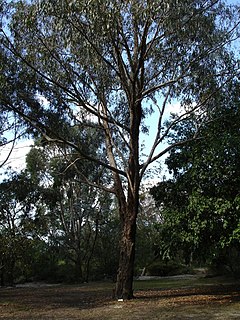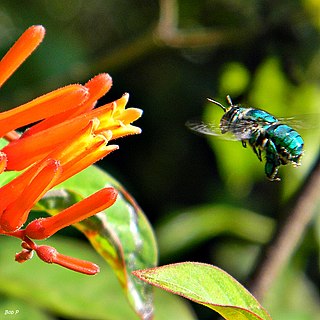
Forsythia, is a genus of flowering plants in the olive family Oleaceae. There are about 11 species, mostly native to eastern Asia, but one native to southeastern Europe. Forsythia – also one of the plant's common names – is named after William Forsyth.

Pentatomidae is a family of insects belonging to the order Hemiptera, generally called shield bugs or stink bugs. Pentatomidae is the largest family in the superfamily Pentatomoidea, and contains around 900 genera and over 4700 species. As hemipterans, the pentatomids have piercing sucking mouthparts, and most are phytophagous, including several species which are severe pests on agricultural crops. However, some species, particularly in the subfamily Asopinae, are predatory and may be considered beneficial.

The green shield bug – Palomena prasina – is a European shield bug species in the family Pentatomidae. The name might equally apply to several other species in the tribe Nezarini, or if referred-to as a "green stink bug", it might more appropriately belong to the larger North American bug, Acrosternum hilare. The adult green shield bug ranges in the colour of their backs from bright green to bronze, without any substantial markings. Green shield bugs are a very common shield bug throughout Europe, including Great Britain & Ireland, and are found in a large variety of habitats, including gardens. They have been found as far north as 63° N latitude.

The Limacodidae or Eucleidae are a family of moths in the superfamily Zygaenoidea or the Cossoidea; the placement is in dispute. They are often called slug moths because their caterpillars bear a distinct resemblance to slugs. They are also called cup moths because of the shape of their cocoons.

Eucalyptus goniocalyx, commonly known as long-leaved box, olive-barked box or bundy, is a species of small to medium-sized tree that is endemic to southeastern Australia. It has rough, fibrous or flaky bark, lance-shaped to curved adult leaves, flower buds in groups of seven, white flowers and cup-shaped, cylindrical or barrel-shaped fruit.

The green iora is a species of bird in the family Aegithinidae. It is found in the Thai-Malay Peninsula, Sumatra and Borneo. Its habitats include lowland forests, secondary forest and mangrove forest. It is threatened by habitat loss, and the International Union for Conservation of Nature (IUCN) has assessed it as near-threatened.

Tettigonia viridissima, the great green bush-cricket, is a large species of bush-cricket belonging to the subfamily Tettigoniinae.

Arctostaphylos viridissima is a species of manzanita known by the common names whitehair manzanita and McMinn's manzanita. It is endemic to Santa Cruz Island, one of the Channel Islands of California.

Chrysanthia viridissima is a species of beetles belonging to the family Oedemeridae subfamily Nacerdinae.

Tettigonia is the type genus of bush crickets belonging to the subfamily Tettigoniinae. The scientific name Tettigonia is onomatopoeic and derives from the Greek τεττιξ, meaning cicada.

Portsdown is a 69.1-hectare (171-acre) biological Site of Special Scientific Interest on Portsdown Hill, on the northern outskirts of Portsmouth in Hampshire.

Euglossa dilemma, the green orchid bee or dilemma orchid bee, is a species of solitary euglossine bee native to a broad area of Central America, and recently introduced to Florida in the United States. It was first detected in Broward County, Florida in 2003, and initially identified as Euglossa viridissima, but further study revealed that E. viridissima as previously defined consisted of two cryptic species, and the one present in Florida was new to science.

The common green racer is a species of venomous snake of the family Colubridae.

Palomena is a genus of shield bugs of the family Pentatomidae and tribe Nezarini; species are found in Europe and Asia.

Tettigonia caudata is a species of bush-crickets belonging to the family Tettigoniidae subfamily Tettigoniinae. It is found over most of Europe mainly in the East. The males of this species prefer to inhabit tall and dense vegetation. This mesohabitat can be compared to that of the T. viridissima which it competes with.

Nezarini is a tribe of stink bugs in the family Pentatomidae.

Hydra viridissima is a species of cnidarian which is commonly found in still or slow-moving freshwater in the Northern temperate zone. Hydra viridissima is commonly called green hydra due to its coloration, which is due to the symbiotic green algae Chlorella vulgaris which live within its body. These creatures are typically 10 mm long and have tentacles that are about half of their length. They are strictly carnivorous and typically feed on small crustaceans, insects and annelids. Hydra are normally sessile and live on aquatic vegetation. They secrete mucous to attach to substrate using their basal disc.
Prasinoxena viridissima is a species of moth in the family Pyralidae first described by Charles Swinhoe in 1903. It was found in Selangor, Malaysia.

Forsythia viridissima, variously called the Chinese golden bell tree, green-stemmed forsythia, greenstem forsythia, and Korean forsythia, is a species of flowering plant in the genus Forsythia, native to southern China and South Korea, and introduced to Japan and the United States. It flowers about two weeks later than other forsythias. It may be of hybrid origin and is believed to be one of the parents of Forsythia × intermedia.




















